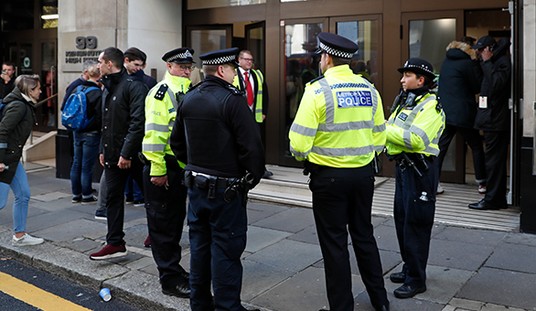It’s an improvement over the advance estimate issued two months ago of -0.1% contraction, but … not by much. At least we won’t have to hear people talk about the greatest contraction evah:
Real gross domestic product — the output of goods and services produced by labor and property located in the United States — increased at an annual rate of 0.4 percent in the fourth quarter of 2012 (that is, from the third quarter to the fourth quarter), according to the “third” estimate released by the Bureau of Economic Analysis. In the third quarter, real GDP increased 3.1 percent.
The GDP estimate released today is based on more complete source data than were available for the “second” estimate issued last month. In the second estimate, real GDP increased 0.1 percent. While nonresidential fixed investment is higher than previously estimated, the revision to GDP has not changed the general picture of the economy (for more information, see “Revisions” on page 3).
The increase in real GDP in the fourth quarter primarily reflected positive contributions from personal consumption expenditures (PCE), nonresidential fixed investment, and residential fixed investment that were partly offset by negative contributions from private inventory investment, federal government spending, exports, and state and local government spending. Imports, which are a subtraction in the calculation of GDP, decreased.
The deceleration in real GDP in the fourth quarter primarily reflected downturns in private inventory investment, in federal government spending, in exports, and in state and local government spending that were partly offset by an upturn in nonresidential fixed investment, a larger decrease in imports, and an acceleration in PCE.
One indicator shows a more positive outlook, at least relatively speaking. Real final sales of domestic product — what actually got sold to end users, as opposed to inventoried — rose 1.9% in Q4. That’s still a stagnation figure, but it does point out the negative impact of inventory transactions in this quarter, and gives perhaps a better indication of the direction of the economy without the swings of government spending. That improved even more than the overall number from the advance estimate, which was 1.1% in January.
Overall GDP in 2012 remained unchanged from the previous interim estimate at 2.2%. That is also a stagnation figure, hardly enough to boost job expansion, and far off from the Obama administration’s economic projections on which they based their budgeting over the last four years. It’s an improvement over 2011’s 1.8%, but again, not by much, and the trendline is dropping downward again.
On the other hand, corporate profits increased 6.8% in 2012, down slightly from a 7.3% increase in 2011. What does that tell us? Corporations are holding onto capital, unwilling to invest it in the American economy. Given the regulatory environment and economic policies of the Obama administration, don’t expect that to change.
Reuters isn’t impressed with the report, either, and notes a rise in weekly initial jobless claims:
Also, the U.S. economy expanded at a sluggish pace in the fourth quarter although a big gain in business investment and higher exports of services led the government to push up its previous estimate for growth.
Gross domestic product expanded at a 0.4 percent annual rate, the Commerce Department said, just below the 0.5 percent gain forecast by analysts in a Reuters poll.
The growth rate was the slowest since the first quarter of 2011 and far from what is needed to fuel a faster drop in the unemployment rate. It was, however, higher than the government’s previous estimate of a 0.1 percent growth rate.
Overall, the news for the economy wasn’t great Thursday.
Initial claims for state unemployment benefits increased 16,000 to a seasonally adjusted 357,000, the Labor Department said. Still, they remained in the middle of their range for this year.
The prior week’s claims figure was revised to show 5,000 more applications than previously reported. Economists polled by Reuters had expected first-time applications last week to rise to 340,000.
Actually, the news isn’t that bad on the weekly claims. We seem to have shifted the window from 360K-380K to 330K-360K over the last couple of months. This metric is all correlative, but the trend is at least improving slightly. If we’re not creating jobs at any sort of rate above treading water, we seem to be losing fewer of them.








Join the conversation as a VIP Member